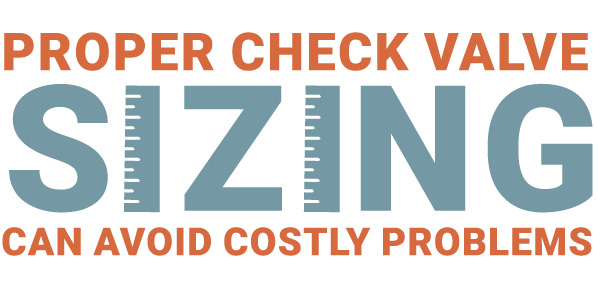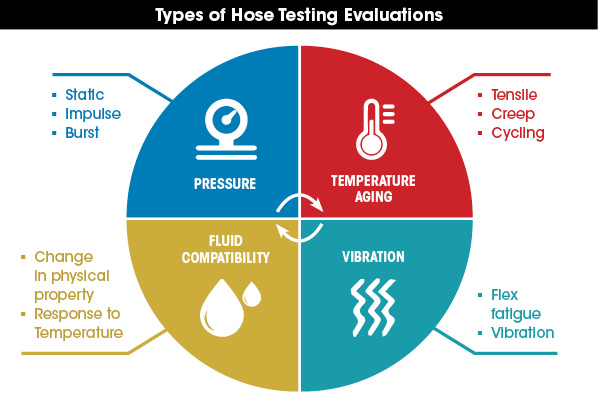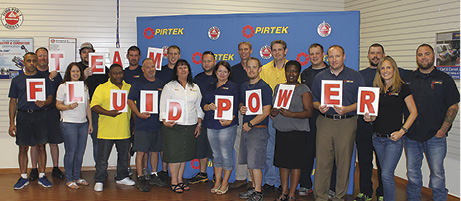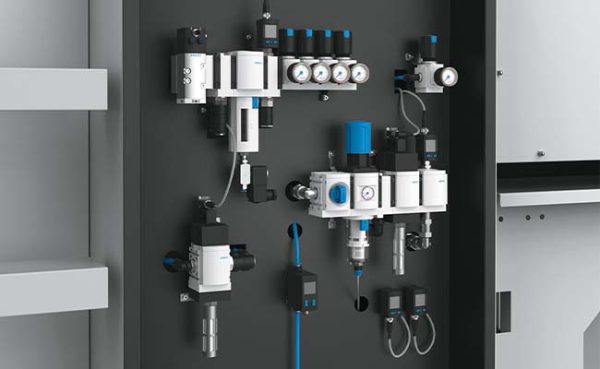2017 Electronics Q&A
 Gary Gotting works in product management for Sun Hydraulics Corp. He has more than 35 years of experience in the fluid power and electro-hydraulics industry internationally, including roles in various design, manufacturing, sales, and marketing positions.
Gary Gotting works in product management for Sun Hydraulics Corp. He has more than 35 years of experience in the fluid power and electro-hydraulics industry internationally, including roles in various design, manufacturing, sales, and marketing positions.
 Michael Hanley, CFPAI/AJPP, CFPS, CFPCC is the vice president of Electro Hydraulic Machinery, a company that integrates electrical controls with hydraulic systems for many different types of industries worldwide. He has an extensive background in mobile and industrial hydraulics.
Michael Hanley, CFPAI/AJPP, CFPS, CFPCC is the vice president of Electro Hydraulic Machinery, a company that integrates electrical controls with hydraulic systems for many different types of industries worldwide. He has an extensive background in mobile and industrial hydraulics.
 Brett McNalley is the product manager of software and wireless products for the Business Development team of HED, Inc. Russ Farrell, sr. applications engineer, and John Kitzerow, product manager, both for the Business Development team, also contributed.
Brett McNalley is the product manager of software and wireless products for the Business Development team of HED, Inc. Russ Farrell, sr. applications engineer, and John Kitzerow, product manager, both for the Business Development team, also contributed.
How have electronics influenced the fluid power industry so far, and do you view this as a positive or negative development?
Gotting: The recognition of need, the development, and the integration of electronics as a critical part of the hydraulics industry is a very positive step. Electronics have typically been viewed as the add-on that was thought about after the fluid power system was designed. Now it is recognized at the start of design, integrated into the fabric of the system, and considered as the heart of the solution, interfacing with the outside world and allowing optimization of operations in real time, increasing efficiency, accuracy, improving machine up-time, and making ROI faster and easier to track.
Hanley: Electronics integration has created a profound ability to increase precision and repeatability of the muscle that fluid power brings to the marketplace. Miniature sensors and circuit boards, as an integral part of today’s valves, have made a positive effect on machine capabilities. Simple joystick electronics can reduce operator fatigue and allow machinery to perform intricate tasks not possible with mechanical valves. The electronic influence will have a major effect on all fluid power considered for future systems.
The ability to “think for you” is one of the many benefits that electronic controls bring to the game. Operator limits can be set, batch processes can be recalled, and flexibility to modify processes are the front-runners of productivity. Advances in electronics have reduced size and costs to the point that these devices are now seen inside valves monitoring pressure and closing the loop for extremely accurate control.
McNalley: It is definitely a positive for the industry, but as with all paradigm shifts, it comes with its own challenges and opportunities. Over the years, electronic controls used for fluid power have improved from simple controls (point-to-point wiring, mimics lever controls) to highly sophisticated controls that improve the safety, reliability, and maintainability of vehicles. With these advances, the machines have become easier to operate, easier to service, and for the OEMs, easier to differentiate from their competition and customize to specific end customers.
One of the primary advantages for end users is the ability of electronic controls to diagnose issues on the vehicle and enunciate those issues to the operator in a clear, concise manner. The faster issues are resolved, the less frustration the operator/owner feels. With the next generation of controls and accompanying telematics offerings, vehicles are starting to notify operators for preventative maintenance needs, allowing for action before the failures occur. This prolongs the service life of the vehicle, lowers cost of ownership, and most importantly, increases uptime of the machine.
With the advancements in consumer electronics (automotive, smart phones/tablets), operators are starting to expect the same level of sophistication from vehicles in the fluid power industry. While we still have some work to do, we are closing that gap. The goal is to give the end customer the feature-rich experience they want while maintaining the robustness required from our industry.
What are the cost savings/benefits to utilizing more electronic controls in fluid power systems?
Gotting: Savings can come on many levels. Using electro-hydraulics can result in parts reduction in systems, lowering overall build cost, size, weight, and machine maintenance while increasing overall efficiency and reducing the total cost of end-to-end ownership.
Embedded controls used with sensors can aid greatly in diagnostics, prognostics, and preventative maintenance, meaning service and key component replacement can take place before a catastrophic stoppage where lost production, urgent and larger repair costs, and machine downtime become a substantial expense.
Hanley: Electronically controlled hydraulic systems rarely offer initial cost savings compared to manually controlled systems. The economy is realized in overall benefits to the end user. Their processes will improve total machine performance, and increased output will be the payback.
McNalley: Electronic controls are significantly more robust and reliable than years ago, and the cost of the controls has come down over the same time. This greatly reduces the need to replace the controls over the lifetime of the vehicle/machine, thus lowering the average lifetime cost of ownership. It also allows for other cost reduction ideas not considered before. The most obvious cost reduction is a lower wire harness cost from reducing the length of wire run by distributing the control modules throughout the vehicle. Shorter wire lengths also mean few connectors (main failure points) and fewer possibilities of damaged wires (shorts/opens).
With electronic controls having higher I/O counts per control, and with the I/O being software programmable to be different I/O types, one control can be programmed for use on many different applications. The more functionality you get from one controller, the lower the system cost. This can also allow for electronic controls to be implemented on lower volume applications if you can utilize a control module already being purchased for a higher volume application. Commonizing on one control across multiple applications can allow for economically incorporating extra I/O that can be utilized for options that are upsold to a customer. The cost of the control is already in the application, so different software just needs to be installed to activate different feature options. In fact, if you utilize service tools for the controls, you can have one application program and then activate different feature options on the assembly line based on what your customer has selected, or even have the customer buy the optional features later from their dealer.
Additional benefits that come with electronic controls are diagnostics. Diagnostics allow for failures in the harness or devices/sensors in the system during the manufacturing process to be detected by the control and made immediately aware to the production assembler. The failed component can be replaced quickly, allowing the assembly line to continue flowing smoothly. The owner can also have easy access to the diagnostic information if a display incorporated into the application can immediately show any failures detected. If the application does not have a display, a service tool can be utilized to display the diagnostics when connected to the control.
As you become more familiar with the capability of software within a control, predictive and preventative features can be designed into an application to tell the owner a sensor or device has potential to fail before it fails (based on life expectancy vs. time since installation, etc.). The owner can then schedule a service appointment when the machine is not being used. Even more advanced predictive algorithms can be developed if data logging and telematics is designed into the application. This data can then be made available to the owner or service personnel to look for patterns based on historical data that can predict when a device might fail before it fails.
Safety features are another benefit to adding electronic controls. The software can be developed to help ensure the operator is only able to run the machine within predefined parameters deemed safe by the manufacturer. The controls can also log if an operator attempts to operate outside these parameters or attempts to override the safety limitations.

What should fluid power professionals and companies do to prepare for and embrace this integration?
Gotting: Corporate leadership and human capital management should plan to invest more in staff that has mechatronics or electronic controls backgrounds to compliment the traditional mechanical and fluid power engineering skills. Companies should also take advantage of the training offered by fluid power organizations that offer cross-functional courses and, where needed, re-train personnel to bolster in-house capabilities to capture these changing opportunities.
Hanley: Future fluid power professionals will need to know as much about electronic equipment as they do about fluid power components. The next big wave of technology for fluid power will be the resultant energy savings from the integration of variable frequency drives with hydraulic systems. Modern industry uses variable frequency controllers of electric motors for better processes and energy efficiency. Application of this new technology will greatly simplify hydraulic circuits. Customers will come running for the energy savings derived from this new marriage, and they will want a single source solution.
McNalley: To embrace this integration, OEMs can now incorporate manuals and troubleshooting videos on the machine, either on the graphical display or a Wi-Fi enabled device. This reduces the cost of printing those manuals and provides a faster, on-machine method for the end users to access that information.
In the past, one of the main points of frustration with electronic controls was physically connecting to the machine. As laptops improved, drivers would become outdated, and service technicians and mechanics would have problems connecting to machines. Embracing newer technology will allow those individuals to connect to the machine wirelessly (Wi-Fi, Bluetooth) or to incorporate service tools into graphical displays, reducing the need to directly connect to the machine.
For preventative maintenance, the machine can track run hours and operation modes to notify owners of filter replacements, oil changes, etc. As mentioned before, this will increase the uptime and lower the cost of ownership of the machine—tangible benefits that will help drive the acceptance and demand for control integration.
Finally, when possible, it is advisable to exceed the minimum requirement. Many Tier-IV engine manufacturers now require a graphical display for engine data; instead of meeting the minimum, use that display for additional information and features. This will help the transition from a “required to have added expense” to a “feature-rich device” that improves the overall experience of the owner/operator.
How much do you see the Internet of Things (IoT) impacting designs and requirements related to fluid power systems?
Gotting: Sensors. These will need to be seamlessly connectable to the master controllers, easily networkable, smaller, most cost effective, and very reliable, becoming commonplace in measuring system operation health and life-limiting parameters while allowing us both to connect to the outside world and look inside the system to optimize performance. Remote monitoring will reduce company costs, improve productivity, lean out maintenance, and drive up-time and efficiencies to the benefit of us all as consumers.
Hanley: Major Internet companies estimate that by 2020, more than 50 billion “things” will be connected to the Internet, the cloud, and each other. The Internet of Things (IoT) has made its way into every corner of business, but has left fluid power lagging a little behind the rest of general industry. Being able to connect directly to a LAN via an Ethernet port right on the component is the direction general industry has been going for years. While this next phase of networking technology is currently offered from almost all electrical control manufacturers, very few fluid power manufacturers have Ethernet-ready components. Mobile equipment has a leg up in this regard because they’ve been using CanBus-type data highways for many years. Their components will mitigate more easily to the Ethernet data highway. Fluid power manufacturers will have to work diligently to get their fair share of the Internet future.
McNalley: Major equipment manufacturers are currently leveraging data collected from their factory-installed telematics units to close the loop on many of their product designs and requirements as it pertains to fluid power systems. The three main areas where we see this impact are
- Voice of Customer: Voice of customer (VOC) drives product requirements and designs in organization, part of which is validating equipment use cases in the field. IoT allows OEMs to close the loop on VOC feedback. This aids in the elimination of customer perceptions and biases, and provides accurate human/equipment metrics to design efforts. Complimentary technology is also automating hydraulic and pneumatic equipment functions, driven by equipment efficiency initiatives, safety regulations, and a changing workforce skillset.
- Statistical QA and System Performance: In addition to leveraging IoT for quality assurance, IoT can be applied to characterizing and optimizing system performance. Off-highway applications experience diverse environmental and life-cycle dynamics. Capturing and characterizing trends and outliers from the equipment ecosystems can provide data that drives the inbound requirements for products and provides the design teams with imperative guidelines.
- Product Development and Engineering: Design intelligence is well understood by IoT companies in the market. The benefits of utilizing IoT solutions can be widespread, such as right-sizing designs by characterizing under or over-engineered products. This can shore up unnecessary cost or field service/warranty campaigns, as well as aid in life-cycle management by prescribing recommended service intervals and maintenance prescriptions via algorithms derived from real, target data populous sets.







